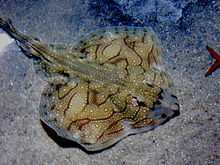Undulate ray
| Undulate ray | |
|---|---|
 | |
| Conservation status | |
| Scientific classification | |
| Kingdom: | Animalia |
| Phylum: | Chordata |
| Class: | Chondrichthyes |
| Subclass: | Elasmobranchii |
| Order: | Rajiformes |
| Family: | Rajidae |
| Genus: | Raja |
| Species: | R. undulata |
| Binomial name | |
| Raja undulata Lacepède, 1802 | |
The undulate ray (Raja undulata) is a species of ray and cartilaginous fish found in the Mediterranean and East Atlantic from southern Ireland and England to the Gulf of Guinea.[1] It is found in areas with mud or sand, and may occur as deep as 200 m (660 ft), though it prefers shallower depths.[1] It is considered endangered due to overfishing.[1]
Description
The undulate ray features a disc-shaped body, triangular in the front and near-circular in the rear, and dermal denticles developed as spines for protection. Median spines are scattered in adults, regular on young. The males have one lateral row each side, whereas the females have three.[2] The eyes are medium-sized and followed by spiracles. The mouth is on the ventral surface and is slightly arched, followed by the five pairs of small gill slits. Tail is as long as body, and has two well separated dorsal fins near its end, usually with two spines between them. The colouring of the dorsal surface varies from light brown to citrine or grey, with darker waved bands and numerous small white patches. Snout and margins are frequently clearer with dark spots.[3] The underside is creamy-white with a greyish margin. It typically weighs about 10 lb (4.5 kg), but can reach to as much as 20 lb (9.1 kg) and 100 cm (39 in) in length.[4]
Distribution and habitat
This species has a patchy and discontinuous distribution in northeastern Atlantic. It is found from southern Ireland and England to Senegal, and in western Mediterranean. It is uncommon overall but can be locally abundant, mainly around north-west of Ireland, in easter side of the English Channel, and near the south coast of Portugal.[5] Like other rays, is usually found on sandy, muddy or detrital bottoms, at depths of 50–200 m from coastal regions to the upper continental slope, even if it's sometimes possible to find it in shallower water.[6]
Biology
There are few data about biology of this species. Using vertebrae as growth markers, maximum lifespan was supposed to be 21-23 years.[7] It's an oviparous cartilaginous fish. The females lay their eggs from March to September.[8] Each egg is a leathery black eggcase with horny corners, known by the common name "mermaid's purse" (as are the eggcases of other rays, skates and sharks). They usually are 72- 90 mm long and 42- 52 mm wide. These "purses" often wash up on beaches after rough weather, although usually they wash up empty, the young ray having already hatched out.[9]
Diet
The ray eats small fish, crustaceans, molluscs and other macrobenthos.[2]
Human interactions
Like other benthonic species of similar size this ray is caught incidentally or intentionally by commercial fisheries using trawls, gillnets, and line gears.[5] It is a common host in public aquariums as fares relatively well.
Protection
Because of its late sexual maturity and low rate of population growth, undulate ray is extremely vulnerable to exploitation by fisheries.[10] In the north Atlantic, populations have declined severely from the Irish area, and there are no longer records of catches of this species in the English Channel. Since 2009 it has been illegal to keep Undulate Rays fished in EU waters due to concerns over the decreasing size of stocks. They must be returned unharmed if possible.[11]
References
- ↑ 1.0 1.1 1.2 1.3 R. Coelho, M. Bertozzi, N. Ungaro & J. Ellis (2003). "Raja undulata". IUCN Red List of Threatened Species. Version 2009.2. International Union for Conservation of Nature. Retrieved February 9, 2010.
- ↑ 2.0 2.1 Hurst, Richard. "Undulate ray Raja undulata" (PDF). Shark Trust. Retrieved 4 January 2015.
- ↑ "Undulate ray (Raja undulata)". Marine Species Identification Portal. KeyToNature Project Consortium. Retrieved 4 January 2015.
- ↑ "Undulate Ray (RAJA UNDULATA)". the European Federation Of Sea Anglers. Retrieved 4 January 2015.
- ↑ 5.0 5.1 "Raja undulata Undulate Ray". Encyclopedia of Life. Retrieved 4 January 2015.
- ↑ Ellis JR, McCully SR, Brown MJ (April 2012). "An overview of the biology and status of undulate ray Raja undulata in the north-east Atlantic Ocean". J Fish Biol 80 (5): 1057–74. doi:10.1111/j.1095-8649.2011.03211.x. PMID 22497373.
- ↑ Coelho R et al (September 2002). Fisheries Biology of the Undulate Ray, Raja undulata , in the Algarve ( Southern Portugal) (PDF). Northwest Atlantic Fisheries Organization Scientific council meeting. Retrieved 4 January 2015.
- ↑ Pollerspöck, Jürgen. "Raja undulata LACEPÈDE, 1802". www.shark-references.com. Retrieved 4 January 2015.
- ↑ "Skate and Ray Eggcase Identification Guide" (PDF). Marine Conservation Society. Retrieved 4 January 2015.
- ↑ Coelho R, Erzini K (October 2006). "Reproductive aspects of the undulate ray, Raja undulata, from the south coast of Portugal". Fisheries Research 81 (1): 80–85. doi:10.1016/j.fishres.2006.05.017.
- ↑ Rossell, Robert. "Raja undulata – undulate ray". National Museums Northern Ireland. Retrieved 4 January 2015.
External links
| Wikimedia Commons has media related to Raja undulata. |
| Wikispecies has information related to: Raja undulata |
